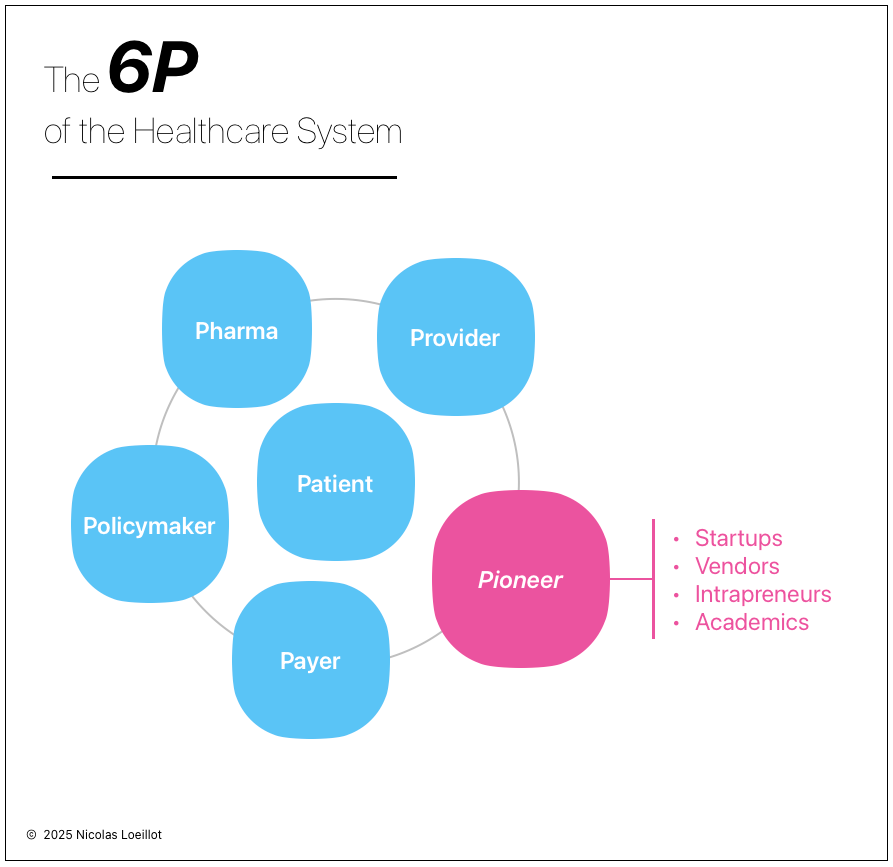Healthcare Needs a Sixth Gear
The 5Ps drive healthcare. But real change often starts elsewhere. It’s time to make room for the sixth P: the Pioneer.

en Français 🇫🇷 plus bas sur cette page.
TL;DR

A System That Needs More Than Harmony
Healthcare is a complex system with no shortage of ambition — to cure, to care, to serve. Yet despite this shared mission, progress is often slow, fragmented, and filled with friction. In It Takes Five to Tango, Dr. Verena Voelter paints a vivid picture of why this is the case: transformation in healthcare requires all five key players — the Patient, the Payer, the Provider, the Policymaker, and Pharma — to move in step like dancers in a delicate tango.
Her book is both a diagnosis and a call to action: we won’t achieve sustainable, value-driven healthcare until these five stakeholders stop working in silos and start co-creating real change.
Reading it, I felt both inspired and restless. Inspired by her clarity. Restless because something still felt missing — a kind of invisible player, one I encounter every day in my work with startups, hospitals, insurers, and researchers. One that isn’t officially invited to the dance floor, but often leads the first steps of transformation.
So I’d like to make a proposal: let’s expand the model. Let’s add a sixth P — the Pioneer.
The 5Ps of Healthcare: A Valuable but Incomplete Map
Dr. Voelter’s framework revolves around five core actors, each essential yet often disconnected:
- Patient – The ultimate beneficiary, yet frequently the least empowered voice.
- Payer – Insurers and reimbursement bodies that shape what care is economically viable.
- Provider – Hospitals, clinicians, and care teams delivering frontline services.
- Pharma – The engine of biomedical innovation, driving new therapies and technologies.
- Policymaker – Governments and regulators setting the rules of the game.
Together, these five Ps form the foundational structure of any health system. Voelter’s insight is that no single P can drive transformation alone. Collaboration is not optional — it is the only way forward.
But here’s the tension: while these five actors hold power and responsibility, they are also bound by their own constraints — legacy infrastructure, risk aversion, budget cycles, institutional inertia. As a result, bold innovation rarely originates within the 5Ps. It’s negotiated, delayed, sometimes diluted.
This is not a critique of the model — it’s a recognition of its limits.
The Missing Force: Why We Need a Sixth P
While the 5Ps define the structure of the system, they often struggle to initiate meaningful change from within. And yet, innovation does happen. It bubbles up from unexpected places. It’s driven by individuals and teams who aren’t waiting for permission — they're building, testing, and sometimes breaking the rules to move things forward.
In my experience, the first sparks of transformation often come from people and organizations that don’t fit neatly into any of the five Ps:
- Startups with radically new approaches to diagnostics or patient engagement.
- Academic teams spinning out applied research with commercial potential.
- Intrapreneurs within hospitals or payers experimenting with new care pathways.
- Tech vendors building tools that challenge how care is delivered or reimbursed.
These actors don’t just "support" the system — they push it. They fill in the white spaces, tackle the unsolved, and take risks the incumbents can't afford. Yet, they're often seen as outsiders or "nice-to-haves", rather than integral to the system's evolution.
And that’s precisely why we need to acknowledge them formally — not just as innovators, but as structural agents of change. We need a sixth seat at the table. We need the Pioneer.

Introducing the Pioneer: The Sixth P
The Pioneer is not a single entity — it’s a mindset embodied by those who challenge the status quo from within or alongside the healthcare system. Pioneers are driven not by entitlement, but by urgency. They are the first to see that "good enough" isn’t good enough — and they act.
Pioneers include:
- Startups crafting digital health tools, AI diagnostics, or novel care models.
- Vendors enabling new workflows, patient journeys, or reimbursement pathways.
- Intrapreneurs inside insurers or hospitals, designing pilots from the ground up.
- Academics translating breakthrough science into deployable solutions.
What unites them is not where they sit, but how they operate: agile, cross-disciplinary, often underfunded — but fiercely committed to solving real problems. They experiment. They prototype. They fail fast. And when successful, they make the impossible suddenly seem inevitable.
At Future of Health Grant, we see this every day. Pioneers bring not only innovation, but energy. They create momentum that can pull the other 5Ps into motion. But for that to happen, they need recognition, access, and above all — collaboration.
Because when a Pioneer succeeds, it's not just their win. It's a win for the whole system.
From Competition to Co-Creation: Towards a 6P Tango
The original “5P Tango” metaphor captures the intricate choreography of the healthcare system — each actor with its own rhythm, its own constraints, yet ultimately dancing together toward a common goal. But today’s reality demands more than coordination — it demands co-creation. And that’s where the Pioneer changes the dance.
Pioneers aren’t just new dancers — they’re often the ones designing the music, the steps, or even the stage. But for their contributions to have lasting impact, we need to make space for them in the system — not as outliers, but as integrated partners in innovation.
This means:
- Inviting Pioneers early into policy discussions, pilot designs, and reimbursement pathways.
- Creating shared metrics that bridge startup speed and systemic safety.
- Funding mechanisms that reward experimentation without punishing failure.
- Cross-sector platforms, like the Future of Health Grant, that broker real collaboration between insurers, startups, providers, and regulators.
Co-creation doesn’t erase power asymmetries — but it can soften them. It doesn’t solve misaligned incentives — but it makes misalignment visible. Most of all, it reframes innovation as a collective responsibility, not a competitive advantage.
A 6P Tango may be harder to coordinate, but it’s the only dance that reflects the complexity — and the opportunity — of modern healthcare.
A More Complete Dance
Verena Voelter’s It Takes Five to Tango is a vital reminder that transformation in healthcare is not about heroics — it’s about alignment. But alignment doesn’t mean rigidity. It means making room for those who move differently, who take the first risk, who provoke the system to evolve.
That’s why we need the Pioneer. Not as an afterthought, but as a sixth, essential force. One that thrives on experimentation, connects silos, and builds what others only imagine.
Adding a sixth P isn’t about breaking the model — it’s about completing it.
If we want healthcare to become more inclusive, agile, and value-driven, we need to recognize that innovation doesn’t just happen within systems. It often happens between them — in the messy, creative spaces where Pioneers work.
The question isn’t whether the Pioneer belongs at the table.
The question is: can the system afford to leave them out?
En Français 🇫🇷
Un système de santé à cinq vitesses. Et si on passait la sixième ?
Le résumé en Audio:

Un système qui a besoin de plus que l’harmonie
La santé est un système complexe, animé par une ambition immense : guérir, soigner, servir. Pourtant, malgré cette mission partagée, le progrès est souvent lent, fragmenté et semé d’embûches. Dans It Takes Five to Tango, la Dre Verena Voelter dresse un tableau saisissant des raisons de cette inertie : la transformation du système de santé exige que les cinq acteurs clés — le Patient, le Payeur, le Prestataire, le Régulateur et l’Industrie Pharmaceutique — avancent de concert, tels des danseurs engagés dans un tango délicat.
Son livre est à la fois un diagnostic et un appel à l’action : nous n’atteindrons pas une santé durable et fondée sur la valeur tant que ces cinq parties prenantes continueront à travailler en silos, sans co-créer un changement réel.
En le lisant, j’ai ressenti à la fois de l’inspiration et de l’impatience. Inspiré par sa clarté. Imapcient, car il me semblait qu’il manquait quelque chose — une sorte d’acteur invisible, que je croise chaque jour dans mon travail avec les startups, les hôpitaux, les assureurs et les chercheurs. Un acteur rarement convié officiellement sur la piste de danse, mais qui initie pourtant souvent les premiers pas de la transformation.
Alors, je voudrais faire une proposition : élargissons le modèle. Ajoutons un sixième P — celui du Pionnier.
Les 5P de la santé : une cartographie utile mais incomplète
Le cadre proposé par la Dre Voelter repose sur cinq acteurs fondamentaux, tous essentiels mais souvent déconnectés :
- Patient – Le bénéficiaire ultime, mais trop souvent la voix la moins écoutée.
- Payeur – Assureurs et organismes de remboursement qui décident de la viabilité économique des soins.
- Prestataire – Hôpitaux, cliniciens et équipes de soins, en première ligne.
- Pharma – Moteur de l’innovation biomédicale, porteur de nouvelles thérapies et technologies.
- Politique – Pouvoirs publics et régulateurs qui fixent les règles du jeu.
Ensemble, ces cinq P forment l’ossature de tout système de santé. L’intuition de Voelter est claire : aucun de ces acteurs ne peut transformer seul le système. La collaboration n’est pas une option — c’est la seule voie possible.
Mais voilà le paradoxe : si ces cinq acteurs détiennent pouvoir et responsabilité, ils sont aussi enfermés dans leurs propres contraintes — infrastructures obsolètes, aversion au risque, cycles budgétaires rigides, inertie institutionnelle. Résultat : l’innovation audacieuse naît rarement au sein des 5P. Elle est négociée, différée, parfois édulcorée.
Ce n’est pas une critique du modèle — c’est une reconnaissance de ses limites.
La force manquante : pourquoi il nous faut un sixième P
Les 5P définissent la structure du système, mais peinent souvent à initier un vrai changement de l’intérieur. Et pourtant, l’innovation existe bel et bien. Elle émerge là où on ne l’attend pas. Elle est portée par des individus et des équipes qui ne demandent pas la permission — ils construisent, expérimentent, transgressent parfois, pour faire avancer les choses.
Dans mon expérience, les premières étincelles de transformation viennent souvent d’acteurs qui n’entrent dans aucune des cinq cases :
- Des startups aux approches radicales sur le diagnostic ou l’engagement patient.
- Des équipes académiques valorisant leur recherche avec un potentiel commercial.
- Des intrapreneurs dans des hôpitaux ou des assureurs, testant de nouveaux parcours de soins.
- Des fournisseurs technologiques qui redéfinissent les modes de prestation ou de remboursement des soins.
Ces acteurs ne « soutiennent » pas simplement le système — ils le poussent. Ils comblent les vides, s’attaquent à l’inexploité, prennent des risques que les institutions ne peuvent se permettre. Pourtant, on les considère souvent comme des outsiders ou des "bonus sympathiques", plutôt que comme des forces structurantes du changement.
Et c’est précisément pour cela qu’il faut les reconnaître officiellement — non seulement comme innovateurs, mais comme moteurs structurels de transformation. Il faut leur faire une vraie place à la table. Il nous faut le Pionnier.

Le Pionnier : le sixième P
Le Pionnier n’est pas une entité unique — c’est un état d’esprit, celui de ceux qui bousculent le statu quo de l’intérieur ou en bordure du système de santé. Les Pionniers ne sont pas mus par un droit, mais par une urgence. Ils sont les premiers à constater que « suffisant » ne suffit plus — et ils agissent.
Les Pionniers, ce sont :
- Des startups développant des outils de santé digitale, diagnostics par IA ou modèles de soins innovants.
- Des fournisseurs facilitant de nouveaux parcours patients ou systèmes de remboursement.
- Des intrapreneurs construisant des pilotes sur mesure dans des institutions.
- Des chercheurs traduisant des percées scientifiques en solutions concrètes.
Ce qui les unit, ce n’est pas leur rôle, mais leur façon de travailler : agiles, pluridisciplinaires, souvent sous-financés — mais résolument tournés vers la résolution de vrais problèmes. Ils testent. Ils prototypent. Ils échouent vite. Et lorsqu’ils réussissent, l’impossible devient tout à coup inévitable.
Au Future of Health Grant, nous en faisons l’expérience chaque jour. Les Pionniers ne se contentent pas d’apporter de l’innovation : ils apportent de l’énergie. Ils créent une dynamique qui entraîne les 5P. Mais pour cela, ils ont besoin de reconnaissance, d’accès — et surtout, de collaboration.
Car quand un Pionnier réussit, ce n’est pas qu’une victoire personnelle. C’est une victoire pour tout le système.
De la compétition à la co-création : vers un tango à 6P
La métaphore du « tango des 5P » décrit bien la chorégraphie complexe du système de santé — chaque acteur avec son propre tempo, ses propres contraintes, mais convergeant vers un but commun. Mais la réalité d’aujourd’hui demande plus qu’une coordination : elle exige de la co-création. Et c’est là que le Pionnier transforme la danse.
Les Pionniers ne sont pas simplement de nouveaux danseurs — ce sont souvent eux qui composent la musique, inventent les pas ou construisent la scène. Mais pour que leur impact dure, il faut leur faire de la place dans le système — non comme des exceptions, mais comme des partenaires à part entière.
Cela implique :
- D’impliquer les Pionniers en amont des discussions politiques, des designs de pilotes, et des modèles de remboursement.
- De créer des indicateurs communs qui relient la vitesse des startups à la sécurité du système.
- De financer l’expérimentation sans pénaliser l’échec.
- De bâtir des plateformes intersectorielles comme le Future of Health Grant, qui facilitent une vraie collaboration entre assureurs, startups, prestataires et régulateurs.
La co-création n’élimine pas les déséquilibres de pouvoir — mais elle les atténue. Elle ne résout pas les incitations mal alignées — mais elle les rend visibles. Et surtout, elle redéfinit l’innovation comme une responsabilité partagée, et non comme un avantage concurrentiel.
Un tango à 6P sera certes plus difficile à coordonner — mais c’est la seule danse à la hauteur de la complexité (et du potentiel) de la santé moderne.
Une danse plus complète
It Takes Five to Tango de Verena Voelter nous rappelle que la transformation en santé ne repose pas sur des héros solitaires — elle repose sur l’alignement. Mais l’alignement ne signifie pas rigidité. Il signifie faire de la place à ceux qui bougent différemment, qui prennent le premier risque, qui provoquent l’évolution du système.
C’est pourquoi nous avons besoin du Pionnier. Pas comme un ajout décoratif, mais comme une force essentielle. Une force qui expérimente, qui connecte les silos, qui construit ce que d’autres n’osent qu’imaginer.
Ajouter un sixième P, ce n’est pas briser le modèle — c’est le compléter.
Si nous voulons un système de santé plus inclusif, plus agile, et orienté vers la valeur, nous devons reconnaître que l’innovation ne se produit pas toujours dans les systèmes. Elle se produit souvent entre eux — dans ces espaces chaotiques et créatifs où les Pionniers opèrent.
La vraie question n’est donc pas de savoir si le Pionnier a sa place à la table.
La vraie question est : peut-on encore se permettre de l’en exclure ?



